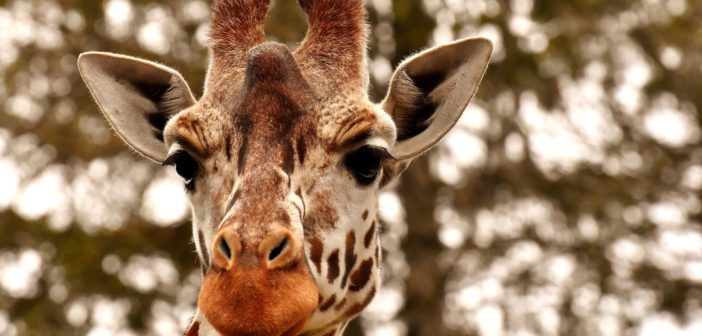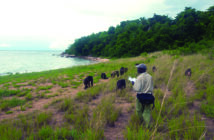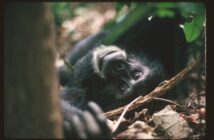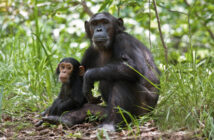The giraffe shot by Tess Thompson Talley of Texas was particularly valuable as a trophy because of his unusual black colouring. He was also a thinking, feeling being. During his 18 or so years we can only imagine what he had experienced. But he had undoubtedly been raised by a caring mother and surely enjoyed the company of the other youngsters in the group. And he must have engaged in many ‘necking’ contests with other males as he grew older. If he had been part of a study, or an animal known to rangers, he would have been easy to identify, with his unusual colouring, and would almost certainly have been given a name – like Black Beauty to match his colour, or some name to match his personality. Did he have a personality? Of course. Today scientific information is accumulating to “prove” what most of us know – that individuals of all manner of different species most definitely have individual personalities. This beautiful giraffe – I think of him now as Black Beauty – would have been no different.
Talley defends her action, saying he was an old bull, that resources were scarce, and he was taking food from younger males. But Black Beauty may well have been enjoying his life, having survived the dangers of predation and disease, and moved on from the hormone induced sexual activity of youth to a more peaceful existence. He could have lived for another six or seven years, but his life was brutally ended and he was reduced, as Talley proudly claims, to 2,000 pounds of meat. It was, she says, her “dream hunt”. She poses with his lifeless body with an expression of joy, of pride on her face that I utterly fail to understand. Will she mount his head on her wall, I wonder? Or spread his skin over the back of a sofa, or make it into a bedspread? What about the skin on that long and graceful neck? The skin of his long and graceful legs? Or perhaps, as I once saw to my utter horror, she will mount Black Beauty’s whole body and have the legs and torso on one floor while the neck and head emerge from the floor of the room above.
There are several quite different issues involved in “sport” hunting. The first is economic gain – those governments or bodies that permit this hunting, claim that it brings in needed revenue that will help support conservation. This is the argument of those African governments that encourage “sport” hunting. And it is the argument of the outfitters who organize the hunts for their clients. In fact, I am told that only a small percentage of such money usually supports conservation.
Secondly, we must question the motivation of the hunter. Typically we hear that hunting is a way of controlling populations. The sportsman who hunts deer in the US is preventing overpopulation and the excuse for hunting grizzly bears and cougars and wolves is to protect livestock and/or to maintain a balanced ecosystem. There are still people who rely on hunting for food. But Native Americans, Inuits and so forth, all deeply respect the animals they hunt, and use every last bit of the dead body. This is very different from the “sport” hunter who usually claims that it is not the killing of the animal that is the goal, but the thrill of the hunt itself. Talley boasts that her “dream hunt” involved a long period of stalking. But if this is true, then surely it would be just as thrilling to stalk an animal and, if this is successful, shoot the target not with a gun but with a camera. And if the target is a lion, rhino or elephant and the hunter is on foot, there will be the added challenge of moving away safely afterwards. Such a photo would indeed be a worthwhile trophy to hang on the wall and brag about! But no – for the “sport” hunter the commemorative photo will show the proud hunter posing with the dead body of the victim.
I have tried very hard to imagine how it would be possible to feel proud and exhillerated about killing a beautiful animal – I absolutely cannot. And giraffes really are beautiful. What’s more they are endangered.
“Most people – including conservationists – are unaware that these majestic animals are undergoing a silent extinction,” said Julian Fennessy, co-chair of the IUCN’s giraffe and okapi specialist group. Giraffe numbers have fallen from over 160,000 in 1985 to just over 97,000 last year. They have already gone from 7 African countries where once they roamed. Habitat loss and habitat fragmentation, human population growth, grazing by livestock, the bushmeat trade and climate change are the main problems, but “sports” hunting has played a role. (CNN)
Somehow it seems particularly shocking when someone enjoys the ‘sport’ of hunting. Talley is not the only one – recently Aryanna Gourdin of Utah was shown proudly posing beside the slumped body of a giraffe she had shot. And we all recall the tragedy of Cecil, and his son. No wonder there is so much violence in the world.

The Jane Goodall Institute is a global community conservation organization that advances the vision and work of Dr. Jane Goodall. By protecting chimpanzees and inspiring people to conserve the natural world we all share, we improve the lives of people, animals and the environment. Everything is connected—everyone can make a difference.









